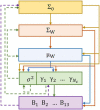A Regional Smoothing Block Sparse Bayesian Learning Method With Temporal Correlation for Channel Selection in P300 Speller
- PMID: 35754766
- PMCID: PMC9231363
- DOI: 10.3389/fnhum.2022.875851
A Regional Smoothing Block Sparse Bayesian Learning Method With Temporal Correlation for Channel Selection in P300 Speller
Abstract
The P300-based brain-computer interfaces (BCIs) enable participants to communicate by decoding the electroencephalography (EEG) signal. Different regions of the brain correspond to various mental activities. Therefore, removing weak task-relevant and noisy channels through channel selection is necessary when decoding a specific type of activity from EEG. It can improve the recognition accuracy and reduce the training time of the subsequent models. This study proposes a novel block sparse Bayesian-based channel selection method for the P300 speller. In this method, we introduce block sparse Bayesian learning (BSBL) into the channel selection of P300 BCI for the first time and propose a regional smoothing BSBL (RSBSBL) by combining the spatial distribution properties of EEG. The RSBSBL can determine the number of channels adaptively. To ensure practicality, we design an automatic selection iteration strategy model to reduce the time cost caused by the inverse operation of the large-size matrix. We verified the proposed method on two public P300 datasets and on our collected datasets. The experimental results show that the proposed method can remove the inferior channels and work with the classifier to obtain high-classification accuracy. Hence, RSBSBL has tremendous potential for channel selection in P300 tasks.
Keywords: EEG; P300; brain-computer interface; channel selection; sparse bayesian learning; temporal correlation.
Copyright © 2022 Zhao, jin, Xu, Li, Sun, Wang and Cichocki.
Conflict of interest statement
RX is employed by the company g.tec medical engineering GmbH. The remaining authors declare that the research was conducted in the absence of any commercial or financial relationships that could be construed as a potential conflict of interest.
Figures







References
-
- Alotaiby T., Abd El-Samie F. E., Alshebeili S. A., Ahmad I. (2015). A review of channel selection algorithms for EEG signal processing. EURASIP J. Adv. Signal Process 2015 1–21.
-
- Arican M., Polat K. (2019). ““Comparison of the Performances of Selected EEG Electrodes with Optimization Algorithms in P300 Based Speller Systems,”,” in in 2019 Scientific Meeting on Electrical-Electronics & Biomedical Engineering and Computer Science (EBBT), (Piscataway: IEEE; ), 1–4.
LinkOut - more resources
Full Text Sources
Miscellaneous

